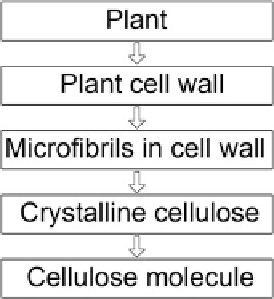Civil Engineering Reference
In-Depth Information
cellular structure in three plant materials, wood, parenchyma and arborescent palm
stems, in related to the mechanical properties of the vegetable fibres (Gibson
2012
). The amount of cellulose in a fibre affects the fibre's mechanical properties.
Fibre's strength and stiffness has been found to correlate weakly with the cellulose
content (Lee
1991
).
Hemicellulose of vegetables is a sort-chain, unlike cellulose, partially soluble
polysaccharides consisting of glucose units. Hemicellulose is embedded in the cell
walls acting as filler between cellulose and lignin (Reddy and Yang
2005
).
Mechanically, hemicellulose contributes little to the stiffness and strength of fibres
or individual cells (Thompson
1993
).
Lignin consists of various aromatic polymers with complex structures. Nonl-
ignocellulosic fibres, for example, potatoes, beets and cotton, are fibres that do not
contain lignin. Lignin binds to cellulose fibres and hardens and strengthens the cell
walls to protect the carbohydrates from chemical and physical damage (Saheb and
Jog
1999
). Lignin plays major roles in determining the mechanical properties of
the cell wall. Generally, fibres with a lower amount of cellulose have a higher
lignin content, which appear finer and more flexible (Sukumaran et al.
2001
).
The most important structures of vegetable fibrous cellulose cell wall and
microfibrils are shown in the diagram Fig.
7
, which provide a clear illustration of
how they are organized in a hierarchical structure (Energy
2010
; Siqueira et al.
2010
).
3.3 Raw Materials
The raw materials of fibrous insulations can be categorized according to the fibre
classification presented in Fig.
3
based on the specific type of insulation product.
Among the vegetable fibres that are regularly used as building insulators, bast
fibres of flax and hemp are the most widely adopted raw materials for thermal
insulations. Tow of these fibres has traditionally been used in insulation tapes
Fig. 7 Schematic diagram of
structures of vegetable
fibrous cellulose cell wall and
microfibrils

